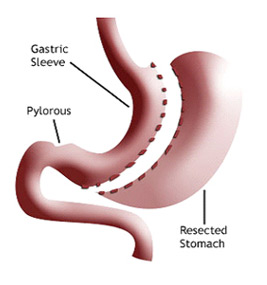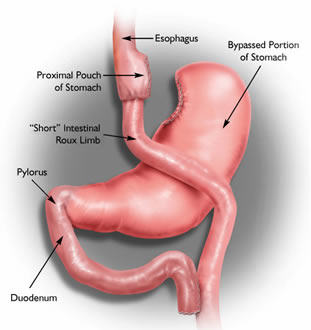Surgical Weight-Loss Options
Sleeve Gastrectomy
During the gastric sleeve surgery, a long, narrow, vertical pouch (approximately 2 to 3 ounces) is created by stapling and removing 85% of the stomach and restricting the volume of food that can be eaten.

Laparoscopic Roux-en-Y Gastric Bypass

Gastric bypass surgery makes the stomach smaller and allows food to bypass part of the small intestine. You will feel full more quickly than when your stomach was its original size, which reduces the amount of food you eat and thus the calories consumed. Bypassing part of the intestine also results in fewer calories being absorbed. This leads to weight loss. The most common gastric bypass surgery is a laparoscopic Roux-en-Y gastric bypass.
In a Roux-en-Y gastric bypass, the stomach is made smaller by creating a small pouch at the top of the stomach using surgical staples. The smaller stomach is connected directly to the middle portion of the small intestine (jejunum), bypassing the rest of the stomach and the upper portion of the small intestine (duodenum). This procedure can be done by making a small incision and using small instruments and a camera to guide the surgery (laparoscopic approach).
Bariatric Revision Surgery
Bariatric revision surgery is a procedure that corrects or improves prior weight-loss surgery. Most of the time, bariatric surgery is successful. People lose weight and maintain a new, healthier lifestyle. However, in some cases, patients find that the procedure deteriorates over time or is no longer as effective for a variety of reasons. Revision surgery can help.
Non-Surgical Weight-Loss Options
The Baptist Weight-Loss Center offers comprehensive non-surgical weightloss options for medical weight management. Our specialists and dietitians focus on learning more about you, your lifestyle and what works best for you. Your personalized weight-loss program may involve goal setting, nutrition counseling, lifestyle education, weight-loss medication and much more.
Dietitian
The Baptist Weight-Loss Center dietitian is specifically trained to provide nutrition plans and counseling based on your personal goals, health condition and lifestyle. Meeting with our dietitian ensures that you receive balanced nutrition advice and prevents potential harm from restrictive or unsuitable diets.
Support Groups
Joining support groups can connect you with others on a similar journey, providing encouragement and shared experiences.
Medication
Weight-loss medications, such as Contrave, Saxenda, Wegovy and Ozempic, may be the right option for you to jumpstart your weight loss.
